
The Fall of Tobruk is a board wargame published by Conflict Games in 1975 that simulates the Second Battle of Tobruk during World War II.

The Fall of Tobruk is a board wargame published by Conflict Games in 1975 that simulates the Second Battle of Tobruk during World War II.
After the British under Archibald Wavell had defeated the Italian 10th Army in Libya in 1940, Wavell was not allowed to continue the offensive to capture the port of Tripolitania. This allowed the Afrika Korps under Erwin Rommel to land, and the Germans went on the offensive. After defeating the British forces around the important port of Tobruk in 1941, forcing them to retreat to Egypt, Rommel attacked Tobruk itself. [1]
The Fall of Tobruk is a two-player board wargame in which one player controls the Axis attackers, while the other player controls the British defenders. The victory condition is very simple: whoever controls Tobruk at the end of the game is the winner. [2]
With over 350 die-cut counters and a large 19" x 25" mounted hex grid map, the game is moderately complex. Like many games of the period, Fall of Tobruk uses an alternating system of turns where the German player acts first, using three phases:
Once the German player completes these phases, the British player is given the same opportunity. This completes one turn, which represents 24 hours of game time.
In 1975, Frank Chadwick designed The Fall of Tobruk, which was then published by Conflict Games.
In a 1976 poll conducted by Simulations Publications Inc. to determine the most popular board wargames in North America, The Fall of Tobruk placed 80th out of 202 games. [3]
In Issue 23 of Moves (October–November 1975), Richard Berg noted that by coincidence, a number of wargames about Tobruk had been published at about the same time, but called The Fall of Tobruk "Possibly the best of the new Tobruk games." He thought the new play sequence "uniquely demonstrates the fluidity of desert warfare," and thought the game was "tense and tough." He concluded, "An intelligent and interested approach to the rules produces possibly the best game on this level and area. By all means, grab yourself a copy of this one." [2]
In his 1977 book The Comprehensive Guide to Board Wargaming , Nick Palmer called Fall of Tobruk a "pleasant tactical game by the makers of Bar-Lev ." Palmer found the combat system to be "fluid", and noted the importance of mines, and subsequently of engineers to remove the mines. [3]
At the 1976 Origins Awards, The Fall of Tobruk was a finalist for the Charles S. Roberts Award in the category "Best Professional Game of 1975". [4]

Operation Sonnenblume was the name given to the dispatch of German and Italian troops to North Africa in February 1941, during the Second World War. The Italian 10th Army had been destroyed by the British, Commonwealth, Empire and Allied Western Desert Force attacks during Operation Compass (9 December 1940 – 9 February 1941). The first units of the new Deutsches Afrikakorps (DAK), commanded by Generalleutnant Erwin Rommel, departed Naples for Africa and arrived on 11 February 1941. On 14 February, advanced units of the 5th Light Afrika Division, Aufklärungsbataillon 3 and Panzerjägerabteilung 39 arrived at the Libyan port of Tripoli and were sent immediately to the front line east of Sirte.

The Western Desert campaign took place in the deserts of Egypt and Libya and was the main theatre in the North African campaign of the Second World War. Military operations began in June 1940 with the Italian declaration of war and the Italian invasion of Egypt from Libya in September. Operation Compass, a five-day raid by the British in December 1940, was so successful that it led to the destruction of the Italian 10th Army over the following two months. Benito Mussolini sought help from Adolf Hitler, who sent a small German force to Tripoli under Directive 22. The Afrika Korps was formally under Italian command, as Italy was the main Axis power in the Mediterranean and North Africa.

Operation Brevity was a limited offensive conducted in mid-May 1941, during the Western Desert Campaign of the Second World War. Conceived by the commander-in-chief of the British Middle East Command, General Archibald Wavell, Brevity was intended to be a rapid blow against weak Axis front-line forces in the Sollum–Capuzzo–Bardia area of the border between Egypt and Libya. Although the operation got off to a promising start, throwing the Axis high command into confusion, most of its early gains were lost to local counter-attacks, and with German reinforcements being rushed to the front the operation was called off after one day.

The Battle of Gazala, also the Gazala Offensive was fought near the village of Gazala during the Western Desert Campaign of the Second World War, west of the port of Tobruk in Libya, from 26 May to 21 June 1942. Axis troops of the Panzerarmee Afrika consisting of German and Italian units fought the British Eighth Army composed mainly of British Commonwealth, Indian and Free French troops.
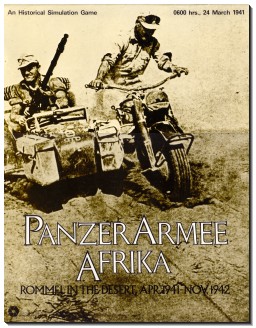
PanzerArmee Afrika, subtitled "Rommel in the Desert, April 1941 - November 1942", is a board wargame published by Simulations Publications, Inc. (SPI) in 1973 that simulates the World War II North African Campaign that pitted the Axis forces commanded by Erwin Rommel against Allied forces. The game was revised and republished in 1984 by Avalon Hill.

Afrika Korps is a board wargame published by Avalon Hill in 1964 and re-released in 1965 and 1978 that simulates the North Africa Campaign during World War II.

Tobruk, subtitled "Tank Battles in North Africa 1942", is a board wargame published by Avalon Hill in 1975 that simulates tank combat in North Africa during World War II.

Men of War is a 2008 real-time tactics video game sequel to Faces of War developed by Ukrainian company Best Way. Players issue orders to and/or take direct control of soldiers on a simulation-driven battlefield.

Operation Skorpion from 26 to 27 May 1941, was a military operation during the Western Desert Campaign of the Second World War. The operation was conducted by Axis forces under the command of Colonel Maximilian von Herff and British forces under Lieutenant-General William "Strafer" Gott. A counter-attack was made on British positions at Halfaya Pass in north-western Egypt, which had been captured during Operation Brevity (15–16 May).Unternehmen Skorpion was the second offensive operation commanded by Rommel in Africa.
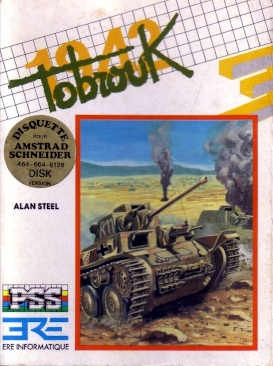
Tobruk: The Clash of Armour is a turn-based strategy video game developed and published by Personal Software Services. It was exclusively released in the United Kingdom for the Commodore 64, ZX Spectrum and Amstrad CPC in 1987. The game is set during the 1941 Siege of Tobruk of the Western Desert Campaign in World War II and revolves around the Allied forces attempts to overthrow German field marshal Erwin Rommel from the city.

Rommel's Panzers is a board wargame published by Metagaming Concepts in 1980 that simulates combat in North Africa in 1941.

El Alamein: Battles in North Africa, 1942 is a board wargame published by Simulations Publications Inc. (SPI) in 1973 that simulates the final four months of the North African campaign during World War II.

Kasserine Pass, in some editions subtitled "The Baptism of Fire", is a board wargame published by Conflict Games in 1972 that simulates the Battle of Kasserine Pass during the North African Campaign of 1942, when inexperienced American forces were attacked by the battle-hardened Afrika Korps under the command of Erwin Rommel. The game was the first created by noted game designer John Hill.
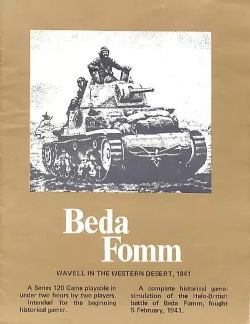
Beda Fomm, subtitled "Wavell in the Western Desert, 1941", is a board wargame published by Game Designer's Workshop (GDW) in 1979 that simulates the Battle of Beda Fomm during World War II. The game was part of GDW's "120 System", games that contained 120 counters, and supposedly could be played in 120 minutes.
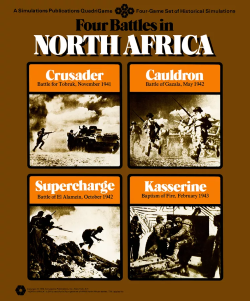
Four Battles in North Africa is a collection of four board wargames published in 1976 by Simulations Publications, Inc. (SPI) that simulate various battles during the North African Campaign of World War II.

Assault on Tobruk, subtitled "Rommel Triumphant, 20 June 1942," is a board wargame published by Simulations Canada in 1980 that simulates the North African Battle of Tobruk during World War II. Compass Games later reissued a new edition of the game.

Cauldron: Battle of Gazala, May 1942 is a board wargame published by Simulations Publications Inc. (SPI) in 1976 that simulates the Battle of Gazala during World War II. The game was originally published as part of the Four Battles in North Africa "quadrigame" — a gamebox containing four games simulating four separate battles that all use the same rules. Cauldron was also published as an individual "folio game."

Crusader: Battle for Tobruk, November 1941 is a board wargame published by Simulations Publications Inc. (SPI) in 1976 that simulates Operation Crusader during World War II. The game was originally published as part of the Four Battles in North Africa "quadrigame" — a gamebox containing four games simulating four separate battles that all use the same rules. Crusader was also published as an individual "folio game."
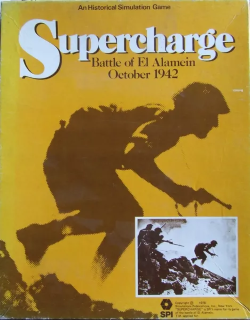
Supercharge: Battle of El Alamein, October 1942 is a board wargame published by Simulations Publications Inc. (SPI) in 1976 that simulates Operation Supercharge during the Second Battle of El Alamein of World War II. The game was originally published as part of the Four Battles in North Africa "quadrigame" — a collection of four games simulating four separate battles that all use the same rules. Supercharge was also published as an individual "folio game."

Rommel: The Campaign for North Africa is a board wargame self-published by designer Loren Sperry in 1973 that simulates the North African Campaign during World War II.